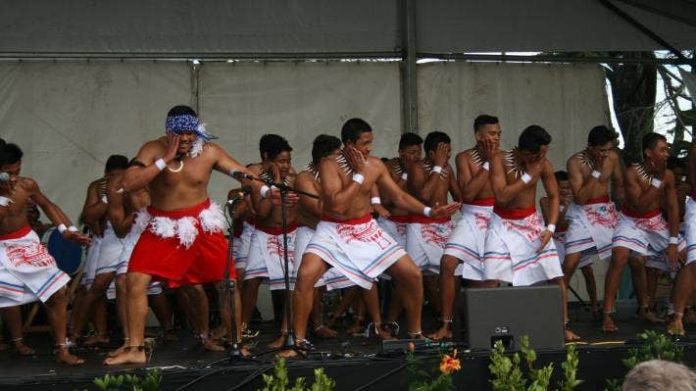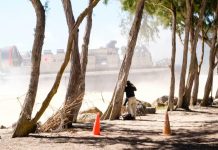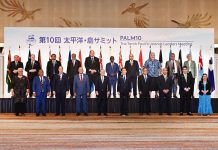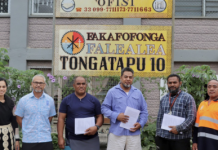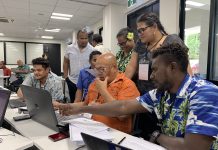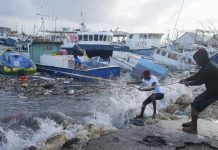By Torika Tokalau
Auckland was promoted as a ‘Mecca’ for Pacific Islanders in the 1950s. They came in their droves, and Tāmaki Makaurau is now home to the South Pacific’s largest Polynesian population – and could soon have its first Pasifika mayor.
Saofa’i and Luataunu’u Samuelu Sauni, with two toddlers in tow, took a leap of faith when they boarded a plane to New Zealand.
It was 1955, and they had heard about job opportunities in a land 3000 kilometres away from Samoa.
They knew nothing about New Zealand or where the plane was going to land.
Their son Papali’i Pale Sauni, who was two years old at the time, said his parents didn’t even know that New Zealand had its own indigenous people.
But his parents came for the money, education and a better life.
It’s an experience shared by many from the Pacific who braved the journey at a time when labour was short in New Zealand after World War II – when the Government decided to look to its Pacific neighbours to raise the country’s economy.
Before then, the Pacific Island community in New Zealand numbered only a few thousand.
Sauni’s family, like many that came after them, chose Auckland specifically because they already had relatives in the region with whom they could stay, and there was a church where they could worship. That was important.
“And work was here,” Sauni, a Pacific consultant, says.
Sauni was born in Samoa in 1953, to a district nurse and a lay preacher. Back then, he was the youngest of two children – his older sister was 2. Five more children arrived after the family moved to Auckland.
Sauni, who has ties to Fale’ula and Faleasiu villages in Samoa, arrived in New Zealand with his older sister and parents when the international airport was still at Whenuapai.
They moved in with his uncle, who owned a three-bedroom house in Ponsonby, overlooking the Harbour Bridge.
It was on Vine Street, and it’s still there today.
Sauni laughs as he remembers how back then, his uncle bought the house for 500 pounds, “but today it’s $500 (US$334) just for the letterbox”.
“So when we came it was my uncle, his wife and two kids, and then my parents and their two children under that roof.
“That small house housed a lot of families coming over here for work and education – the same reason our parents said yes to the invitation by the Government to come here.”
Throughout his childhood, Sauni remembers watching a swarm of adults coming to live with them.
His parents joined the Adventist church in Mackelvie St, a congregation filled with middle-class palagi (white) families, dominated by men. But it was also there that they met more Pacific Island families who had had a similar journey to New Zealand.
The church was a fundamental part of the family’s orientation into Kiwi culture, as it was for many new Pacific migrants.
Sauni’s parents eventually bought a house in Millais St, and later at Māngere in south Auckland.
“It was faith that brought them here, and I really trust that faith in them, and they worked their magic, for dad to work and mum to be a full-time home provider for us seven kids.”
His dad, who was known as Sam, worked at Westfield Freezing Works company until he retired, and his wife looked after the children, with some part-time jobs on the side.
Families that arrived in Auckland later from the islands ventured to Wellington to work in the car factories, but Sauni says the church held his parents in Auckland.
His dad died five years ago, and his mum is now 95, still living in the same family home in Māngere.
Sauni left Auckland with his own family for work for a while, but the city beckoned him back, “because this is home”.
Pacific comes to Auckland
The church played a huge part in Auckland becoming a hub for Pacific migration into New Zealand in the 1950s.
At a time when 90 per cent of Samoans were Christianised, people making the bold move overseas needed a place to meet their spiritual needs.
The Pacific Islanders’ Presbyterian Church Newton was the only Pacific church in New Zealand at the time, and became a welcoming beacon for recent arrivals to the central suburb of Ponsonby.
One migrant described Ponsonby as a “working class ethnic ghetto entry point for new migrants … a most fascinating diverse neighbourhood”.
Dr Melani Anae recalls how exciting it was, with people from different ethnic groups learning about their new home together.
Anae, a founding member of the Polynesian Panthers, and Pacific studies academic at the University of Auckland, lived in Ponsonby after her family moved to New Zealand in the 1950s.
“People called it [Ponsonby] a slum, and it was – the housing was appalling,” she says.
“In the 1950s, 1960s, toilets were outside, rats infested homes. Houses looked tidy, but housed many, many migrant families at one time.”
In 1945, at the end of the Second World War, there were fewer than 2200 Pacific people in the country – mostly those from the Cook Islands, Niue and Tokelau who had unrestricted access into New Zealand because of citizenship.
Migration accelerated after the war, as demand for labour grew in New Zealand’s expanding secondary industries. Anae explains the islands themselves were becoming decolonised, and there was a push for Pacific people to become independent.
The Samoans came in large numbers in the 1950s, choosing New Zealand because it was close, and because Samoa has been administered from Wellington after the First World War. (It had been previously being colonised by Germany, which lost the war and had its colonies stripped away by Allied powers.)
Anae, whose parents came from Samoa, says while the Kiwi occupation of the islands was an “unhappy experience”, it still brought knowledge of New Zealand to the islands. She adds that the arrival of Christianity “opened up the western world to the Pacific”.
New Zealand was painted as a Mecca, the land of milk and honey, where streets were lined with gold. There was education, technology and telecommunications – all unheard of in Samoa.
After the Samoan wave in the 50s, Tongans arrived en masse in the 60s, also attracted to the world of opportunity that New Zealand offered.
“All I heard growing up was the rhetoric that our parents came for a better life,” reflects Anae. “But unfortunately that was not the case for a number of reasons.”
Pacific people filled the factories and were happy to do the unskilled, dirty jobs the palagi turned down.
Anae’s dad worked six days a week at a paperback factory, and while he loved that his work allowed him to provide for his family and put food on their table, it came at a cost.
“I hardly saw him. To them, they were living the dream and when the recession hit, everything changed and Pacific people bore the brunt of racist policies.”
In the 1970s, gentrification pushed Pacific people out of central Auckland to other centres. Churches moved with the people, and Pacific houses of worship soon appeared in other parts of New Zealand.
When immigration requirements proved hard for people from Samoa, Tonga, Fiji and other islands, New Zealand was used as a stepping stone to Australian migration.
Dawn Raids
The Dawn Raids in 1974 were a historic moment for Pacific people. New Zealand governments – both Labour and National – instructed migration officials and police to crack down on Pasifika overstayers.
A 1968 amendment to the Immigration Act helped lay the groundwork for the Dawn Raids. The law change allowed the deportation of those who had overstayed their work permits. It also required people to produce a work permit or passport to prove their immigration status, if asked.
Homes were raided late at night, and people were stopped in the street. If you didn’t have a passport, you were in trouble.
Anae explains what this meant in her book, The Platform: The Radical Legacy of the Polynesian Panthers.
“Those who did not comply on the spot could be arrested, kept in a holding cell without a warrant, and in some cases deported…”
Massey University’s Professor Paul Spoonley says the Labour government of the time was unusual and somewhat divided on the issue, making conciliatory remarks about the Pacific while simultaneously cracking down on overstayers.
In 1974, the year before New Zealand’s next general election, the raids began.
Police and immigration officials targeted Pasifika people in a bid to remove alleged overstayers. They went to homes and churches, and targeted factories and hotels. They used dogs. New Zealand citizens were also caught up in the raids.
In August 2021, Prime Minister Jacinda Ardern made an official apology to members of the Pasifika community for the racist treatment they had endured during the Dawn Raids.
Tears flowed freely at Auckland Town Hall, packed with Pacific Islanders and their families, as Ardern expressed “sorrow and regret” for what had happened.
A Pacific business hub
Pacific individuals and businesses contribute an estimated $8 billion to New Zealand’s GDP each year, across a variety of industries.
Minister for Pacific Peoples Aupito William Sio, in a recent report about Pacific men and women in business, said they were significant contributors to the economy, despite facing adversity, challenges and inequities.
Auckland in particular remains the business hub for Pacific people, with two thirds of Pacific residents and over half of Pacific business owners located in the region.
Tofilau Bernadette Pereira, who came to New Zealand in 1998 with her husband and son, doesn’t mince her words when she says Auckland and the country as a whole owe a lot to the Pacific community.
Her family had intended to move to Australia and had shipped all their belongings ahead to Melbourne from Vanuatu.
“We were going to move somewhere neutral, not Samoa, not Nouméa, but Melbourne. But we detoured here for a holiday because most of my siblings were here,” she says.
“And the rest is history.”
She dreams of the day that Auckland has its first Pasifika mayor, and is a big supporter of mayoral candidate Efeso Collins.
“We have a son of the Pacific who has put his hand up,” she says. “This is our time, this is our moment.”
Pereira says Pacific people have had a massive impact on Tāmaki Makaurau, and “we now need that reflected at the head of the table”.
Auckland’s future
Efeso Collins is another of the many whose parents were Pacific migrants.
They moved to New Zealand in the 60s, and started a family after meeting at the Orange Hall on Karangahape Rd. They started out living in Ponsonby, before moving to settle in Ōtara.
Collins believes the time has come for a Pacific mayor in Auckland.
“Pacific people’s contribution to Auckland has been huge,” he says. “We’ve helped to build this city, and we’re such a respective community that we could never say it like that.”
“But I think its important that we tell the story that we are part of the fabric of the Auckland narrative.
“The more we grow confident in being proud of our contribution, the more we will see ourselves as being equal partners to these opportunities.”
University of Auckland’s professional teaching fellow in Pacific Studies, Lemoa Henry Sevesi Fesuluai, says Collins’ candidacy is a beautiful moment for the community.
“We’ve been a part of Auckland’s story for such a long period of time, and we have so much more that we will contribute to this city.”
He says the Pacific community has thrived in Auckland, in a way that it never really has in other centres like Wellington and Christchurch.
“There’s a comfortability about Auckland,” he says. “It’s just big enough, it has a Pacific flavour about it and the churches are flourishing here as well.”
Fesuluai says the cheapness and accessibility of Pacific food in Auckland is another huge drawcard.
“Whatever you can get in south Auckland, you can get out west or east. Pacific people have grown our own little mini centres within Auckland and everyone has adjusted and adapted, even the dairies, to suit the Pacific lifestyle.
“That’s why Pacific people remain, why new people from the islands come to Auckland. There is more family here.”
Fesuluai says there’s still room for improvement, and Auckland could do with better policies to suit one of its biggest ethnic groups. But even so, there’s a lot to love about the city.
“The grass is green here in Auckland.” he says.
SOURCE: STUFF NZ/PACNEWS






